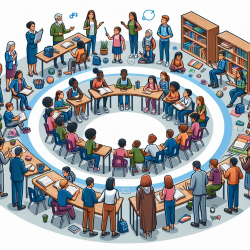As practitioners in the field of speech-language pathology, our ultimate goal is to create inclusive environments where all children can thrive. The recent research article titled Using Stakeholder Involvement, Expert Knowledge and Naturalistic Implementation to Co-Design a Complex Intervention to Support Children’s Inclusion and Participation in Schools: The CIRCLE Framework provides valuable insights into how we can achieve this goal. This blog will explore the key outcomes of this research and how practitioners can implement these findings to improve their practice.
The CIRCLE Framework: An Overview
The CIRCLE (Child Inclusion: Research into the Curriculum, Learning, and Education) Framework is designed to enhance teachers' confidence and competence in providing universal first-level supports for children with additional support needs. The framework was co-designed with extensive stakeholder involvement, including teachers, health professionals, and parents, ensuring that it is both practical and effective in real-world settings.
Key Components of the CIRCLE Framework
The CIRCLE Framework focuses on four main areas:
- Environment: Emphasizes the importance of adapting the physical and social environment to support inclusion.
- Structures and Routines: Highlights the need for consistent routines and structures to help children anticipate transitions and required actions.
- Motivation: Focuses on understanding children's interests, values, and abilities to keep them engaged and motivated.
- Skills: Identifies specific skills that need support, such as attention, concentration, and social-emotional skills.
Implementing the CIRCLE Framework in Your Practice
To effectively implement the CIRCLE Framework, practitioners should consider the following steps:
- Conduct Environmental Assessments: Use tools like the CIRCLE Inclusive Classroom Scale (CICS) to identify environmental barriers and supports. This tool helps teachers assess the physical and social environment and make necessary adaptations.
- Utilize the CIRCLE Participation Scale (CPS): This tool helps identify factors impacting children's participation in school. It guides teachers in providing appropriate supports and strategies tailored to individual needs.
- Engage in Collaborative Planning: Work with other professionals, including teachers, occupational therapists, and parents, to develop and implement individualized support plans.
- Focus on Universal Design for Learning (UDL): Incorporate UDL principles to create flexible learning environments that can accommodate the diverse needs of all students.
- Provide Ongoing Professional Development: Ensure that all staff members are trained in using the CIRCLE Framework and understand the importance of inclusive practices.
Encouraging Further Research
While the CIRCLE Framework provides a solid foundation for inclusive practices, ongoing research is essential to refine and expand its application. Practitioners are encouraged to engage in research activities, such as conducting case studies, participating in collaborative research projects, and sharing their findings with the broader educational community.
To read the original research paper, please follow this link: Using Stakeholder Involvement, Expert Knowledge and Naturalistic Implementation to Co-Design a Complex Intervention to Support Children’s Inclusion and Participation in Schools: The CIRCLE Framework.










